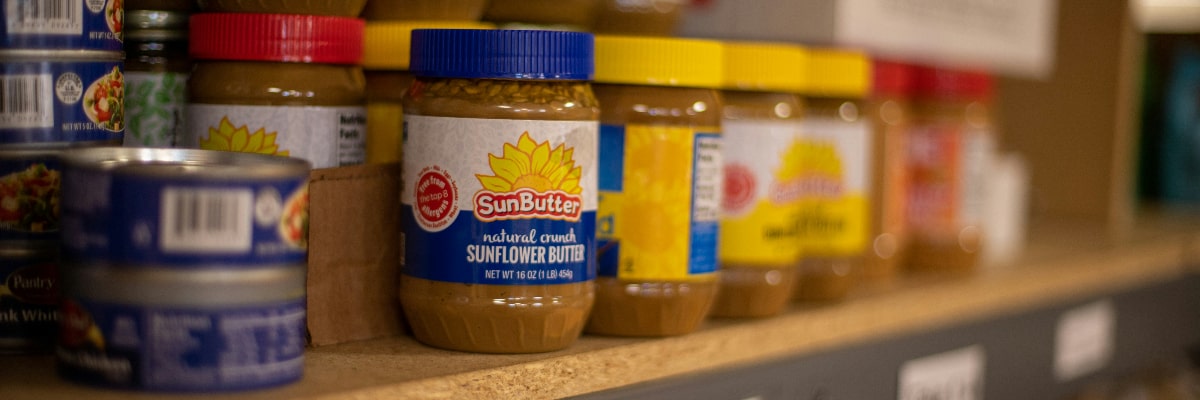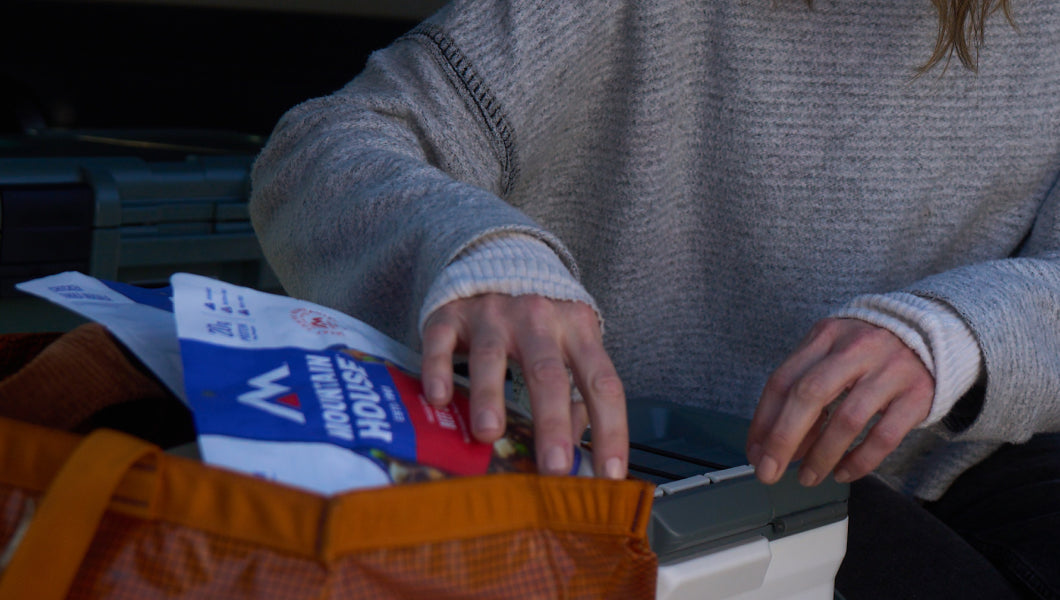Inspired for an Adventure? Check out Beef Stroganoff - Pouch and Beef Stew - Pouch
Add description, images, menus and links to your mega menu
A column with no settings can be used as a spacer
Link to your collections, sales and even external links
Add up to five columns
Add description, images, menus and links to your mega menu
A column with no settings can be used as a spacer
Link to your collections, sales and even external links
Add up to five columns


From an evening power outage to the weeks of turmoil following a major natural disaster like a hurricane or earthquake, the world has a habit of occasionally wreaking havoc with our daily routine. Whether these situations are just inconvenient or catastrophic, it’s always a smart idea to have emergency supplies stored and at the ready in case the unexpected happens to you.
Amongst these supplies must be an adequate reserve of food and water—the absolute fundamentals. A well-prepared supply of food provides peace of mind, knowing that you have access to nutritious and shelf-stable foods that can sustain you and your family members until normal conditions are restored.
Long-term food storage can look different for different people, but fortunately, products like Mountain House make stocking up on emergency rations easy. Our freeze-dried meals are lightweight, come packaged in easy-to-store containers, boast the longest proven shelf life on the market—and, best of all, they taste absolutely delicious! Let’s run down some of the best long-term food-storage tips so you’re ready to hunker down when the next contingency comes knocking at the door.
What Types of Foods to Store for Emergency Situations
Mountain House provides meals that are an excellent option for long-term emergency food storage due to their superior taste, quality, and convenience. Survival fare, as it turns out, can be both nutritious and lip-smacking—at least when it comes from a company with a half-century reputation as a leader in the freeze-dried food industry. Mountain House ensures that each freeze-dried meal retains its flavor, texture, and nutritional value, and they are guaranteed to still taste delicious in 30 years. These meals are easy to prepare, requiring only water (hot water if possible, but not necessary), making them ideal for situations where cooking resources may be limited. Additionally, Mountain House offers a wide variety of meal options, catering to different dietary needs and preferences. The compact packaging makes storing and organizing your emergency food straightforward and space-efficient.
Other types of long-lasting foods that can be good to add to your survival food storage supply include:
-
Canned goods
-
Dried foods like pasta, rice, beans, lentils, and oats
-
Dehydrated fruits and meats
-
Nut butters like peanut butter
-
Seeds and nuts
-
Spices and condiments
Including a variety of these items helps create a well-rounded and nutritious food supply.
How Much to Store
Our recent article explains how to calculate the amount of emergency food you need to store away. Factors include the size of your family, the caloric requirements of each individual, and any special dietary needs. The general rule of thumb when it comes to disaster preparedness is to have what you need to get by for at least 72 hours, but, naturally, larger supplies give you more security in the event things take much longer to get back to normal.
Our Mountain House emergency food supply kits come in buckets or boxes that are very easy to store. We help make planning simple by offering kits with enough meals for three days, 14 days, 30 days, three months, six months, and one year.
Don’t Forget Water
Ensuring you have safe and accessible water when you need it most is extremely important. When estimating how much water to include in your emergency supplies, it’s typically recommended that you stockpile at least one gallon of water per person per day in your emergency water supply.
Be sure to factor in what you’ll need for cooking (including for those Mountain House delicacies!). And remember: Besides stockpiling bottled water, it’s a good idea to equip yourself with the means to purify water in case you need to rely on questionable sources.
How and Where to Store Long-Term Emergency Food
A supply of emergency rations doesn’t do much good if it’s improperly stored. You want to make sure any long-term food supplies stay sheltered away from moisture, high temperatures, and direct sunlight. A cool, dry, and dark storage space—that’s the ideal setting for your emergency rations. Avoid exposing the food to room temperatures above 75°F (24°C) to maximize shelf life. Basements, closets, pantries, and spare rooms are common places where people store their emergency food supply.
Place items such as rice, granola, sugar, spices, and the like in resealable containers (a screw-top jar, for instance) to preserve freshness and keep out insects, rodents, and other pests. Wrap perishable snacks such as crackers in plastic bags and keep those in a resealable container, too. Rotate your stock regularly, and be sure to use older items first. Label all your containers with the date you restocked and expiration dates to easily be able to gauge your food’s level of freshness. Periodically inspect your food items to make sure they’re in good condition. Discard expired items, containers that have been punctured, swollen or rusted cans, and any foods that smell or look spoiled. Don’t take risks with foodborne illnesses.
A couple more pluses of Mountain House: our waterproof pouches and airtight #10 cans and buckets. Our containers are ideal for maintaining and storing emergency food for the long term.
Figuring Out What To Use When
Let’s say your power goes out for an extended period. How should you prioritize your rations? Eat what’s most vulnerable to spoilage first, namely those perishables in your refrigerator and on the pantry shelves. As the FDA notes, an unopened fridge can maintain foods at a safely frosty temperature (at or below 40 degrees Fahrenheit) for approximately four hours.
Freezer items should be next on your list: A properly insulated and completely full freezer that isn’t opened can keep items safe for around two days (less if it’s only partly full). As long as a food item still contains ice crystals, it should be OK to eat—and it can be refrozen. Try to minimize opening the fridge and freezer doors to preserve as much of their cold as you can. A good strategy is to keep a regularly updated list of stored items taped to your freezer so you know what’s in there and where: That cuts down on costly rummaging time. If electricity isn't likely to come back for some time, the USDA recommends sticking block or dry ice inside the refrigerator.
Once you’ve worked through your perishables, move on to those items with longer shelf lives. A simple and effective way to arrange non-perishable foods by their expiration date (whether indicated by a “use-by” label on a package or the date you filled a container) is to keep older items in front and newer ones in the back. That way you’re reaching first for the foods that need to be eaten soonest.
Mountain House provides quick, easy, and mouth-watering meal options that you can always count on. We are the leader in the emergency food department in terms of shelf life with our 30-Year Taste Guarantee! A manufacture or ‘Best By” date of a given Mountain House product can be found on its packaging. Refer to the information in our Just in Case...® FAQs section to determine the specific shelf life.
In Case of Damage
If your emergency food supply gets tampered with, for example, if floodwaters breach your food supply, you should get rid of any items that might have come into contact with water or have been damaged. In the case of floodwaters, the FDA explains you can still use all-metal cans and retort pouches if they weren’t damaged or otherwise compromised by floodwaters: You should take off their labels (which can foster microbes), wash the cans or pouches with soap and water, rinse them with potable water, and then sanitize them using either boiling water or a bleach solution.
Stock Up on Mountain House
Whether you’re outfitting a 72-hour bug-out bag or a disaster shelter—or you’re just looking to spice up your pantry options—turn to Mountain House, your go-to source for the highest-quality, best-tasting, and longest-lasting freeze-dried emergency meals.
Not currently looking to stockpile for a disaster situation? Many of our customers reach for Mountain House cans and pouches for everyday at-home dinners, camping trips, backpacking trips, hunting excursions, and much more. From the kitchen to the backwoods, from routine evenings to disaster zones, Mountain House always delivers!

How to Get Kids Involved in Family Emergency & Survival Planning

20 Best Survival Food Supplies for Emergency Preppers


Stay Hungry for Adventure
Sign Up for Delicious Outdoor Meals & Exclusive Offers!
By clicking ‘Join Now’, I agree to the Terms of Service and Privacy Policy.


Join the adventure
©2024 Mountain House — All Rights Reserved.
Your Cart is Empty
Continue ShoppingYour Cart
Subtotal
$0.00
EXPRESS PAYMENT METHODS AVAILABLE IN CHECKOUT
Taxes and Shipping Calculated at Checkout














